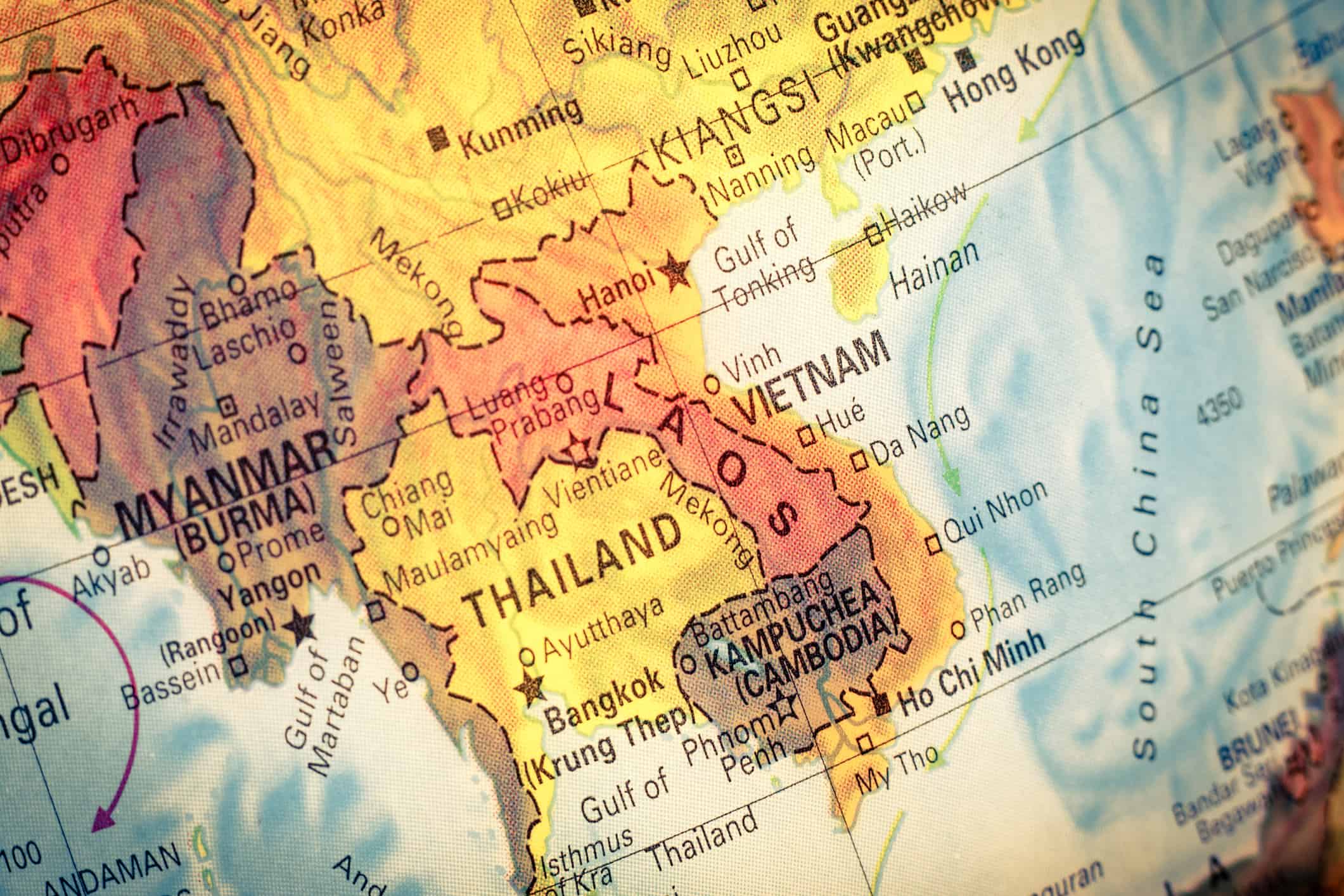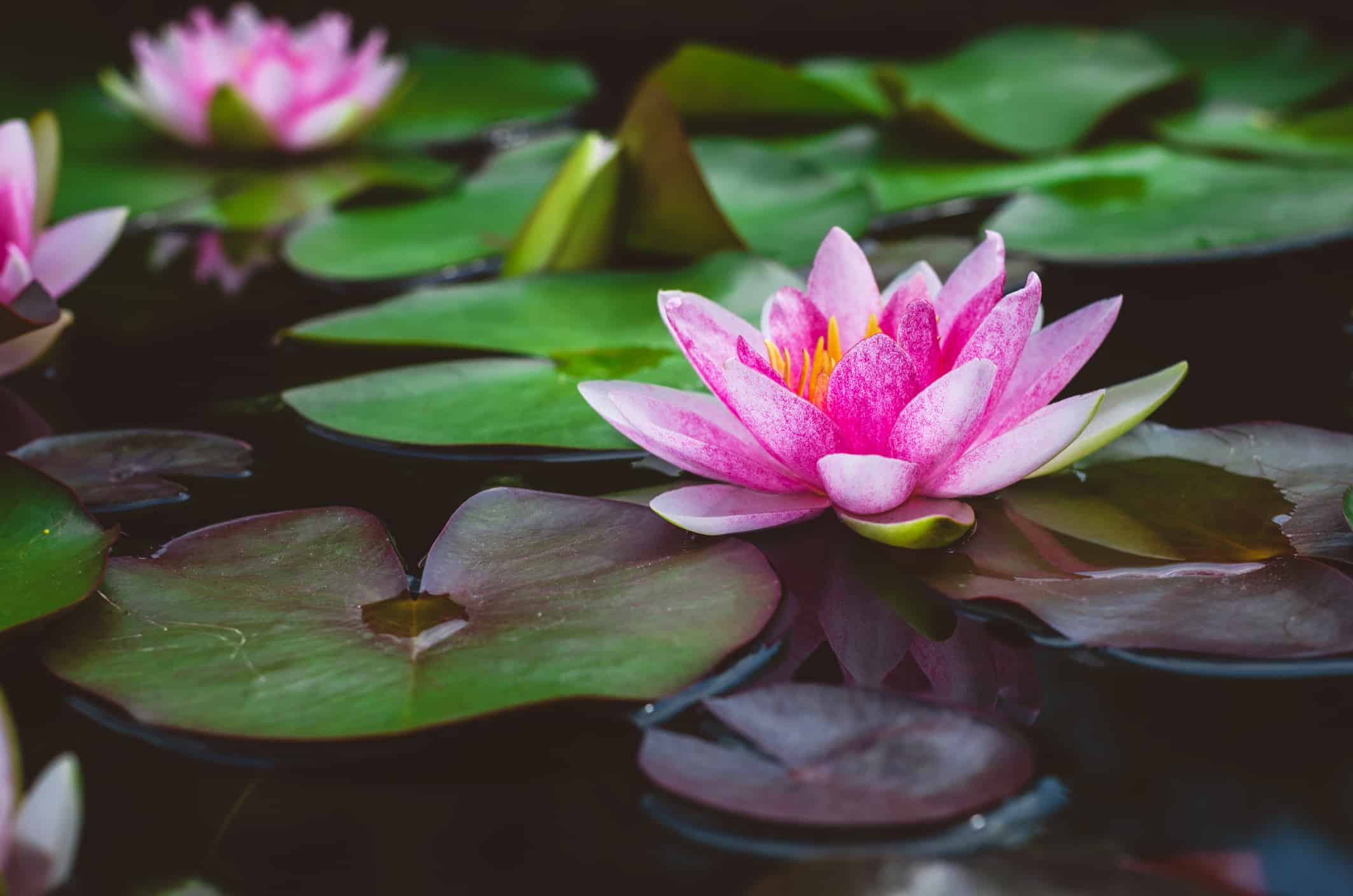Vietnam is a country in Southeast Asia. This long, narrow country takes up over 127,000 square miles in the eastern part of the Indochina peninsula. The countries of China, Laos, and Cambodia border Vietnam. In the east and the south, Vietnam has miles of coast on the South China Sea. Vietnam’s diverse terrain includes big rivers, swampy deltas, fertile rice farms, and more than a thousand miles of coastline. Across the mountains, forests, wetlands, and coasts of Vietnam live thousands of species of plants and animals. Among these is a widely-recognized symbol. This emblem is the beautiful national flower of Vietnam: the lotus.

Vietnam is bordered by China, Laos, and Cambodia and has miles of coast on the South China Sea.
©iStock.com/hansslegers
What is the Geography of Vietnam Like?
Originally, Vietnam’s landscape was covered by tropical forests. Though much of the country’s woodland environment has been destroyed, most of Vietnam’s mountain and hill land is still covered by jungle greenery. The country’s fertile rice fields are possible by the low and flat marsh created by the Mekong River system. The climate is tropical, hot, and very humid. Depending on the part of the country, the hot and rainy season can last for months. Some parts of Vietnam have temperatures above 90 degrees Fahrenheit year-round. In many parts of Vietnam, each summer brings a stormy monsoon season. Other regions have consistent rains throughout the year. Each of these variations results in slightly different growing habits for the lotus plants, which do grow throughout the country.
The national flower of Vietnam, the lotus, is popular in part because it is widespread across Vietnam. As a beautiful flower recognized as a symbol of the Vietnamese people and culture, the lotus is prevalent in art, medicine, and even architecture. This article explores the appearance, history, cultural significance, and scientific classification of the lotus. By the end, you will know all about the unique importance of the lotus to the people of Vietnam. Together, we will also discover some of the key attributes of this tropical plant.

The national flower of Vietnam is the lotus, which is widespread across the country.
©iStock.com/Khong Giang
What is Vietnam’s National Flower?
The national flower of Vietnam is the lotus flower. You can find beautiful flowers blooming across the country, with their blossoming season varying by region of the country. Typically, you can find lotus fields across Vietnam blossoming between the months of May and August with gorgeous white or pink flowers. You can also find representations of the lotus flower throughout Vietnam, as a decorative pattern, part of local art, a symbol in temples and other buildings, and part of the work of artists and musicians.
Each year, the people of Vietnam celebrate the birth of the modern country with celebrations commemorating its 1945 independence. The Vietnamese National Assembly selected the lotus to be the national flower of Vietnam in 2013. However, beyond this vote, the true love of the lotus is evidenced by its prevalence throughout local art, poetry, and architecture.
A member of the Advisory Council on Vietnam’s National Flower told Vietnam News that the best representation of Vietnam’s lotus flowers is the the pink lotus, which is chosen to represent the “noble mind and pure spirit of the Vietnamese people.”
What is the Lotus?
The national flower of Vietnam, the lotus, is also known as the “Asiatic lotus.” The scientific name for this species is Nelumbo nucifera. It is one of two species of lotus, along with the American species Nelumbo lutea. However, while there are only two distinct species, there are many varieties of the Asiatic lotus. As a result, the appearance of lotus plants can vary immensely. Lotus varieties come in a wide range of colors, sizes, and other characteristics. In general, lotus plants produce beautiful, fragrant flowers with 24 petals, with each flower reaching up to 12 inches across. Though the roots of a lotus grow in the soil of marshes and ponds, the flowers and leaves float on the water’s surface. There, the flowers reach toward the sunlight and emit a sweet fragrance.
Lotus flowers come in multiple colors, with each color said to have a specific meaning in Vietnamese culture and tradition. Some of the most common colors you will see for the lotus flowers are white or shades of pink, from pale pastel pink to a deeper rose color. However, lotus flowers also appear in varieties that blossom in vibrant yellow, blue, purple, and green.
When you sniff a lotus blossom, you may notice that the flower’s smell is slightly citrus-like with spicy undertones, while being sweet.

The pink lotus represents the “noble mind and pure spirit of the Vietnamese people.”
©iStock.com/Lquang2410
Where Does the Lotus Grow?
Lotus Plant Growing Conditions
In Vietnam, the lotus grows in ponds, lakes, and water gardens. There, the lotus plants blossom during the summer months, producing flowers that bloom for about three days. Once the blossoming season starts to close, the lotus plant will stop producing flowers. Vietnam is historically an agricultural country. Many farmers work rice paddy fields. Fishermen work the rivers and streams. In general, this wet, tropical landforms many practices that are essential to daily life. In this context, the lotus is a representation of another aspect of agriculture in this wet, humid, tropical environment. Lotus plants grow across all of Vietnam, appearing naturally in the country’s ponds and lakes.
In general, lotuses need fairly deep water in order to thrive. When they grow naturally in the wild, look for lotus plants in lakes that are 10 or 12 feet deep. However, you may find cultivated lotuses, such as those found in home water gardens or in parks, in much shallower water environments. Lotus plants are generally adaptable to these conditions. It is most important that they receive adequate sun. If seeking to cultivate lotus plants in a garden, ensure that they receive at least six hours of sun every day. The lotus plants also need to access sufficient nutrients. In the wild, these come from the fertile soil in ponds and lakes. When cultivated, you should fertilize the plants regularly.

Though the roots of a lotus grow in the soil of marshes and ponds, the flowers and leaves float on the water’s surface.
©iStock.com/Thithawat_s
Lotus Farming
After the Vietnam war, it became more common for farmers to cultivate lotus plants as a crop. As the lotus gained importance as a commercially-grown flower sold for people to decorate their homes, use for medicinal and culinary purposes, grow in gardens from seed, and preserve, lotus farming has also gained prominence in Vietnam. The Duy Tien District of Ha Nam Province is one of the largest areas for lotus growing in the northern part of Vietnam. In flood-prone areas, such as in the communities north of Hanoi, lotus farming is an alternative to rice cultivation. In these areas, lotus farmers cultivate paddies of lotus plants. Farmers then sell the lotus flowers, seeds, and other parts of the edible plant. In turn, these products are converted into tea, food, and decorations.
What is the Cultural Significance of the Lotus as the National Flower of Vietnam?
Many Vietnamese people consider the lotus to be the national flower of Vietnam. This is separate from any official government declarations. This national popularity is longstanding and reflects the flower’s lasting historic and cultural significance. In Vietnam, the lotus is one of several plant species with unique cultural value. Other significant plant species in Vietnam are pine, bamboo, and chrysanthemum.
In general, many people believe that the lotus flower represents divinity, spirituality, and other aspects of the Buddhist religion. Because the lotus so frequently appears in Vietnamese songs, poetry, art, and literature, it is a commonly-used metaphor for the Vietnamese people. One example of this is the way that farmers and other average citizens of Vietnam describe the lotus as representing resilience and purity. Some people resonate with the way that lotus flowers grow out of mud, rising above to float in beauty on the water, as a representation of their people rising in triumph with dignity. Some people call lotus flowers the “flowers of the dawn.” This alludes to the way the flower blossoms above the water before closing up and sinking underneath the water’s surface at night.

You can find the lotus flower throughout Vietnam, as a decorative pattern, symbols in temples and part of local artwork.
©iStock.com/NgKhanhVuKhoa
What Are the Common Uses for the Lotus Plant?
In addition to their decorative uses, people in Vietnam use lotus plants for medicinal and culinary purposes. For many years, lotus tea has had an important place in Vietnamese tea traditions. Since centuries ago, drinking lotus tea has been associated with royalty and the strength of nobility. Even today, many believe that drinking tea made from the lotus plant imparts medicinal benefits and brings good health to those who drink it. This belief motivated Vietnamese people to create many different customs associated with drinking lotus tea.
In addition to this, the lotus plant is entirely edible. You can find parts of the lotus plant in recipes for a variety of cultural dishes and medicinal remedies. For example, some people believe that the lotus seed can cure common ailments such as insomnia and eye pain. Others believe that it can improve circulation by relaxing the blood vessels. Every part of the plant can be used in these recipes, with dishes calling for everything from the lotus root to the lotus rhizome for dishes such as salads as well as desserts. Others make soup or even deep-fry the flower petals to make a crunchy, chip-like snack.
Aside from these uses, as the national flower of Vietnam, you can also find many songs, poems, and stories that incorporate the lotus. Every year, when Vietnam celebrates the country’s independence, the lotus blossom appears as a symbol of the people and their national pride.
What Are the Other National Symbols of Vietnam?
The lotus is likely one of the most highly-regarded and easily-recognized symbols of Vietnam. is regarded as Vietnam’s national flower in the hearts of its people. However, the people and government of Vietnam have also chosen other symbols to represent their culture on the global stage. These include a flag, a national anthem, and a coat of arms.
Here are some other national symbols, in addition to the national flower of Vietnam:
- The Vietnamese dragon is a common symbol in Vietnamese folklore, representing the prosperity and power of the country and its rulers in history.
- The national tree is a species of bamboo called Bambusa ventricosa, also known as “Buddha Belly Bamboo.”
- The national bird is the species Lanius tigrinus, also known as the tiger shrike.
- The water buffalo is the national animal of Vietnam.
These are just a few of the symbols that represent the people, culture, and history of Vietnam. If you visit the country, look for beautiful lotus blossoms in the ponds and lakes across the land. If you do not see the lotus flowers in real life, you can certainly spot them adorning buildings, in the country’s art, or on the menu of restaurants and tea shops! When you see these lovely flowers, know that they are a widely-loved symbol and Vietnam’s national flower, representing its history, culture, and people.
The photo featured at the top of this post is © Alex Lomas, CC BY 2.0
Thank you for reading! Have some feedback for us? Contact the AZ Animals editorial team.






